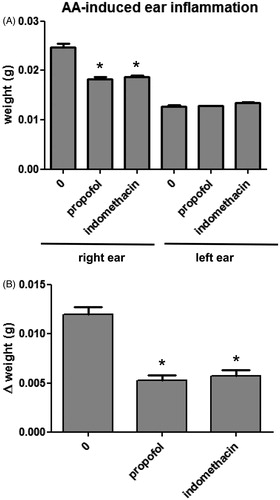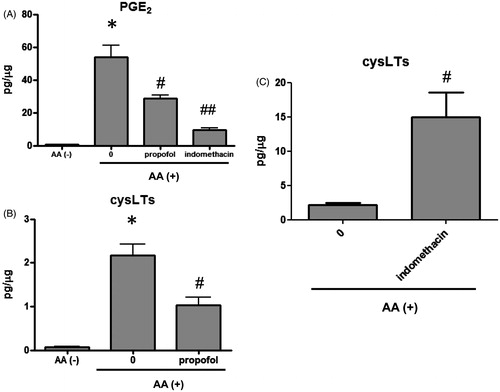Figures & data
Figure 1. Arachidonic acid (AA)-induced ear inflammation. AA (1 mg/mouse) was topically applied to the right ear and vehicle alone to the left ear. One hour later, discs of ear tissue were excised and edema determined by the difference in weight between the right (AA-treated) and left (AA-untreated) ear samples. To test drug effects, propofol (100 mg/kg) or indomethacin (15 mg/kg) was given IP at 5 and 30 min, respectively, before the AA application. Weights of the right (AA-treated) and left (AA-untreated) ears of the mice (A), and the differences (B) between these weights (reflecting level of edema) are shown. n = 5/group. *p < 0.001 vs 0 (that of right ear in (A)).

Figure 2. Myeloperoxidase (MPO) activity in arachidonic acid (AA)-induced ear inflammation. AA (1 mg/mouse) was topically applied to the right ear; 1 h later, ear biopsies were taken, and MPO activity was subsequently measured. Propofol (100 mg/kg) was given IP 5 min before AA application. One unit of MPO was defined as the amount of MPO that generated taurine chloramine to consume 1.0 µmol TNB/min at 25 °C. n = 7–8/group. *p < 0.005 vs AA (−). #p < 0.01 vs 0.

Figure 3. Tissue prostaglandin E2 (PGE2) and cysteinyl leukotriene (cysLTs) concentrations in AA-induced ear inflammation. (A) Tissue PGE2. (B) cysLTs. AA (1 mg/mouse) was topically applied to the right ear; 1 h later, ear biopsies were taken for measurement. Propofol (100 mg/kg) and indomethacin (15 mg/kg) were given IP 5 and 30 min, respectively, before the AA application. (C) Production of cysLTs after AA alone or AA combined with indomethacin pre-treatment. From a statistical point of view, indomethacin results are presented separately due to the high cysLT concentrations. n = 5/group. *p < 0.001 vs AA (−); #p < 0.01, ##p < 0.001 vs 0.

